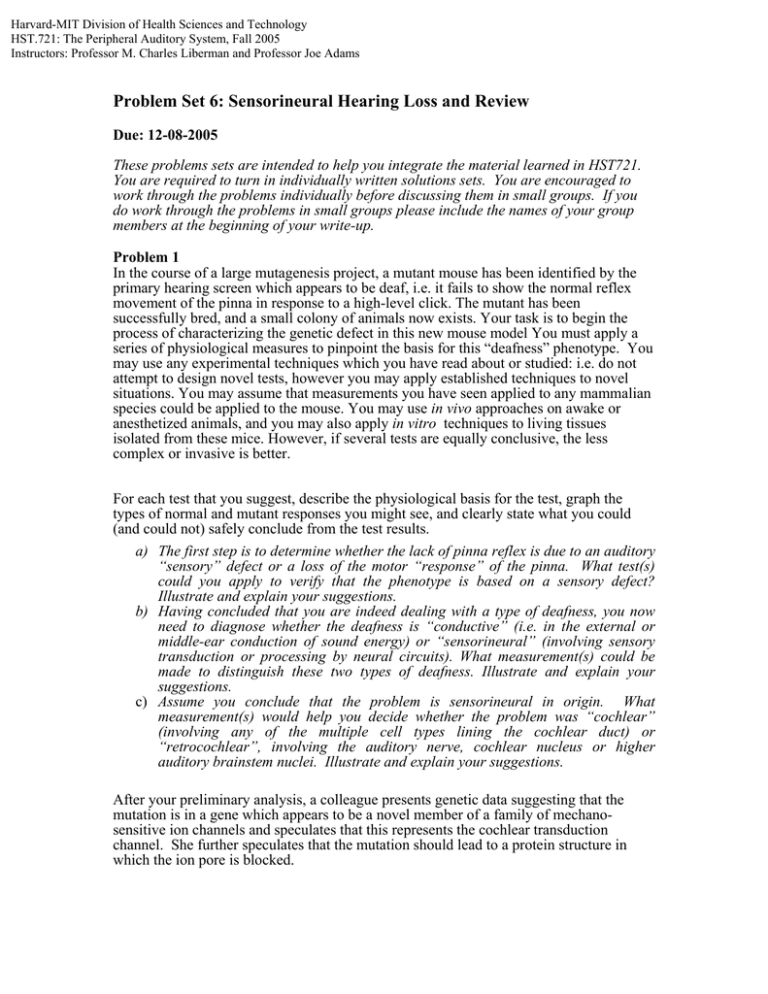Harvard-MIT Division of Health Sciences and Technology
advertisement

Harvard-MIT Division of Health Sciences and Technology HST.721: The Peripheral Auditory System, Fall 2005 Instructors: Professor M. Charles Liberman and Professor Joe Adams Problem Set 6: Sensorineural Hearing Loss and Review Due: 12-08-2005 These problems sets are intended to help you integrate the material learned in HST721. You are required to turn in individually written solutions sets. You are encouraged to work through the problems individually before discussing them in small groups. If you do work through the problems in small groups please include the names of your group members at the beginning of your write-up. Problem 1 In the course of a large mutagenesis project, a mutant mouse has been identified by the primary hearing screen which appears to be deaf, i.e. it fails to show the normal reflex movement of the pinna in response to a high-level click. The mutant has been successfully bred, and a small colony of animals now exists. Your task is to begin the process of characterizing the genetic defect in this new mouse model You must apply a series of physiological measures to pinpoint the basis for this “deafness” phenotype. You may use any experimental techniques which you have read about or studied: i.e. do not attempt to design novel tests, however you may apply established techniques to novel situations. You may assume that measurements you have seen applied to any mammalian species could be applied to the mouse. You may use in vivo approaches on awake or anesthetized animals, and you may also apply in vitro techniques to living tissues isolated from these mice. However, if several tests are equally conclusive, the less complex or invasive is better. For each test that you suggest, describe the physiological basis for the test, graph the types of normal and mutant responses you might see, and clearly state what you could (and could not) safely conclude from the test results. a) The first step is to determine whether the lack of pinna reflex is due to an auditory “sensory” defect or a loss of the motor “response” of the pinna. What test(s) could you apply to verify that the phenotype is based on a sensory defect? Illustrate and explain your suggestions. b) Having concluded that you are indeed dealing with a type of deafness, you now need to diagnose whether the deafness is “conductive” (i.e. in the external or middle-ear conduction of sound energy) or “sensorineural” (involving sensory transduction or processing by neural circuits). What measurement(s) could be made to distinguish these two types of deafness. Illustrate and explain your suggestions. c) Assume you conclude that the problem is sensorineural in origin. What measurement(s) would help you decide whether the problem was “cochlear” (involving any of the multiple cell types lining the cochlear duct) or “retrocochlear”, involving the auditory nerve, cochlear nucleus or higher auditory brainstem nuclei. Illustrate and explain your suggestions. After your preliminary analysis, a colleague presents genetic data suggesting that the mutation is in a gene which appears to be a novel member of a family of mechanosensitive ion channels and speculates that this represents the cochlear transduction channel. She further speculates that the mutation should lead to a protein structure in which the ion pore is blocked. d) How would you expect the structure and ultrastructure of the inner ear to be altered by this mutation? Defend your prediction. e) What would you expect to measure, in vivo, from this mutant mouse with respect to a) sound-evoked otoacoustic emissions (e.g. distortion product OAEs), b) compound action potentials or c) endolymphatic potentials from the cochlea? Illustrate and explain your predictions. f) What would you expect to measure, in vitro, from outer hair cells in this mutant mouse if you performed an electromotility analysis. Describe the nature of your electromotility assay and iIlustrate and explain your predictions. g) What type of in vitro tests would you carry out to provide the most compelling test of the hypothesized nature of this mutation? Illustrate and explain your suggestions.







